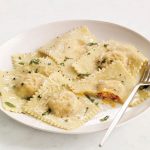 Pasta stuffed with various mixtures and poached in salt water, moistened with beef gravy, and sprinkled with cheese.
Pasta stuffed with various mixtures and poached in salt water, moistened with beef gravy, and sprinkled with cheese.
Tiny turnips and little lambs—that is what you are metaphorically eating when you sit down to a meal of ravioli and agnelotti. The two pastas—ravioli stuffed with cheese and agnelotti stuffed with meat—both derive their names from Italian sources that describe their plump shape: raviolo, meaning little turnip, is the diminutive of the Italian ravi, which developed from the Latin name for turnip, rapa. This Latin source also gave rise in the fourteenth century to rape, the original English name for the turnip; after the introduction of the word turnip in the sixteenth century, rape shifted its meaning and became the name of a plant whose seeds yield an edible oil. Although unrelated to the word rape that means sexual assault (a word that derives from the Latin rapere, meaning to seize), the apparent resemblance of the two words has recently prompted farmers to rename rape as canola, a shortened form of the phrase CANada Oil Low Acid. The Italian name of the other pasta, agnelotti, meaning little lamb, is the diminutive of agnello, which developed from the Latin name for lamb, agnus. In English, the oldest of these two words is ravioli: it appeared briefly in the fifteenth century as rafiol, the name of a kind of meatball, and then was forgotten for many centuries until readopted with its current sense and spelling in the mid nineteenth century. Agnelotti is an even more recent adoption into English, probably within the last twenty years.
Small, square-shaped dumplings produced by combining egg and flour dough, filled with either cheese or meat, and boiled in rapidly boiling water are commonly referred to as “ravioli.” Typically served with a tomato-based sauce and grated Parmesan cheese, this dish is a popular choice for Italian cuisine enthusiasts.
Delightful squares of pasta, known as stuffed envelopes, emerge onto the culinary scene, enclosing a delectable blend of well-seasoned ricotta cheese or ground meat. Boiled to perfection akin to macaroni, these tantalizing parcels offer a plethora of serving options. They can be accompanied by a luscious tomato sauce and sprinkled with grated cheese, creating a harmonious marriage of flavors. Alternatively, they serve as a delightful garnish, lending their presence to elevate the richness of soups. The filling within these pasta envelopes presents a wide array of possibilities. It may consist of cooked chicken or meat, delicately moistened with a savory sauce. Alternatively, the filling can be a creamy or pureed amalgamation of vegetables, adding a touch of velvety elegance to each bite.
